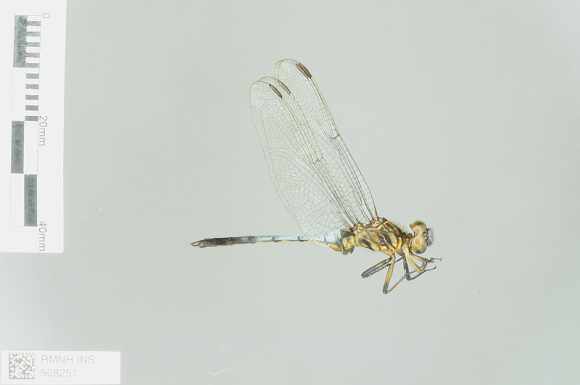Orthetrum stemmale (Burmeister, 1839)
Bold Skimmer
Type locality: Mauritius, no locality data available.
Diagnosis
Male is similar to O. brachiale by (a) being widespread and abundant; (b) frons at most with dorsal dark markings running down onto shields; (c) Pt usually 3 mm or longer, 10% of Hw length or more; (d) 2 cell-rows in radial planate, sum of cell-doublings in all wings 11-29 [4-29]³; (e) Abd usually shorter than Hw (if longer, S4-6 with transverse bands); (f) lobe of hamule prominent, space between it and hook usually gaping cleft; (g) pale markings on S4-6 form transverse subapical bands, longitudinal streaks closer to dorsal than lateral carinae, or segments largely pale. However, differs by (1) labrum often with black border rather than all pale; (2) subcostal Ax dark (pale locally in coastal Mozambique, Tanzania and Kenya, as well as dry regions of N Kenya, Somalia and Ethiopia; (3) lobe with perpendicular ridge connected to ridge on border; (4) hook of hamule large with flat and angled border, like head of bird. [Adapted from Dijkstra & Clausnitzer 2014; this diagnosis not yet verified by author]
Habitat description
Standing and often temporary waters in open areas in forest, but sometimes also in open landscapes or shaded by gallery forest. Often with a soft (like muddy) bottom, probably especially pools in stream beds. From 0 to 2200 m above sea level, but mostly below 1000.
Distribution

Male (mature) © Allan Brandon

Male (young) © Allan Brandon
 Abdominal segment 2 (lateral view) |
Map citation: Clausnitzer, V., K.-D.B. Dijkstra, R. Koch, J.-P. Boudot, W.R.T. Darwall, J. Kipping, B. Samraoui, M.J. Samways, J.P. Simaika & F. Suhling, 2012. Focus on African Freshwaters: hotspots of dragonfly diversity and conservation concern. Frontiers in Ecology and the Environment 10: 129-134.
Barcode specimen(s):

Male; Democratic Republic of Congo, Province Orientale, Lower Lomami © Dijkstra, K.-D.B.

Male; Democratic Republic of Congo, Province Orientale, © Dijkstra, K.-D.B.

Male; Tanzania, Kigoma Region, Lower Malagarasi Basin © Dijkstra, K.-D.B.

Male; Liberia, Nimba County, East Nimba Nature Reserve © Dijkstra, K.-D.B.

Male; Liberia, Nimba County, Mt Tokadeh © Dijkstra, K.-D.B.

Male; Tanzania, Tanga Region, East Usambara Mts © Dijkstra, K.-D.B.

Female; Tanzania, Tanga Region, East Usambara Mts © Dijkstra, K.-D.B.

Male; Tanzania, Tanga Region, East Usambara Mts © Dijkstra, K.-D.B.

Male; Tanzania, Tanga Region, East Usambara Mts © Dijkstra, K.-D.B.

Male; Democratic Republic of Congo, Katanga, © Dijkstra, K.-D.B.

Adult, male; Angola, Uige Province, new campus site and environs © Clausnitzer, V. & Dijkstra, K.-D.B.

Adult, male; Angola, Uige Province, new campus site and environs © Dijkstra, K.-D.B.
References
- Burmeister, H. (1839). Handbuch der Entomologie. Zweiter Band, Befondere Entomologie. Zweite Abtheilung. Kauterfe. Gymnognatha. (Zweite hälfte; vulgo Neuroptera). Enslin, Berlin 755-1050. Odonata, 805-862.
- Schouteden, H. (1934). Annales Musee Congo belge Zoologie 3 Section 2, 3, 1-84. [PDF file]
- Longfield, C. (1955). The Odonata of N. Angola. Part I. Publicacoes culturais Companhia Diamantes Angola, 27, 11-63. [PDF file]
Citation: Dijkstra, K.-D.B (editor). African Dragonflies and Damselflies Online. http://addo.adu.org.za/ [2024-07-27].

